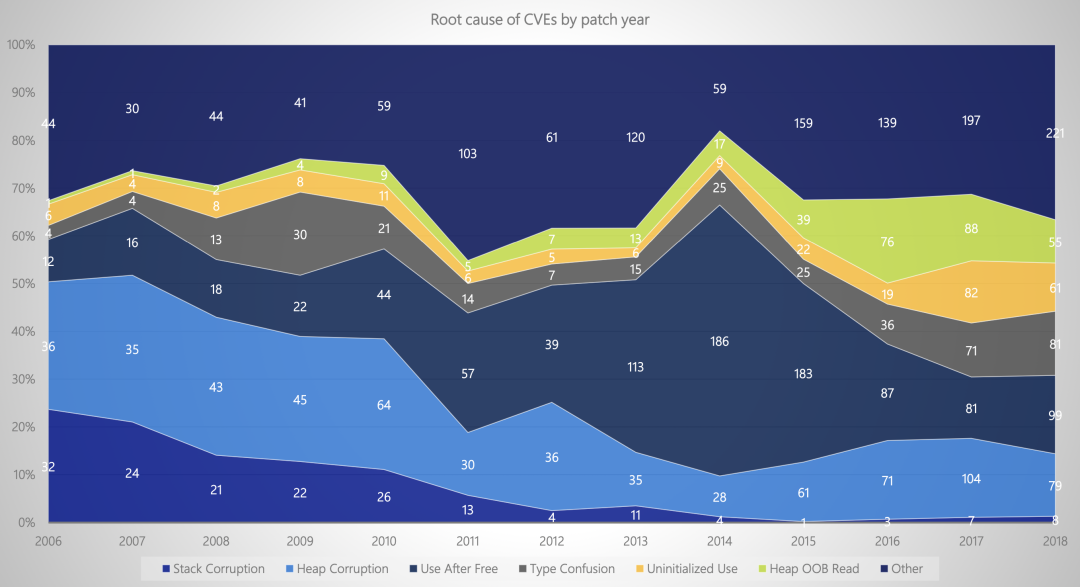
2024年起,DARKNAVY公众号开启新的专栏「技术研报」,主要面向攻防研究领域的技术读者,不定期发布深蓝技术实践中的一些思索。
以下为深蓝技术研报的第一篇。
前言
已了解MTE原理的读者可跳过此章节。
MTE利用ARMv8的TBI (Top-Byte Ignore) 特性,使用指针的高4 bits存储tag,在每个进程中有一段专用的内存用于存储tag。当为内存指定了某个tag后,程序必须带上正确的tag访问内存,若tag错误,程序抛出错误信号SIGSEGV,如下图所示:
指令集提供了系列指令来操作tag,此处举例说明MTE的基本用法:
; x0 is a pointerirg x1, x0stg x1, [x1]ldr x0, [x1]
IRG (Insert Random Tag) 指令为指针x0生成一个随机tag,将结果保存至x1中。 STG (Store Allocation Tag) 指令将tag应用至内存中,生效的长度取决于颗粒度,一般为16字节。 LDR (Load Register) 使用带有tag的指针读取内存。
Chrome - PartitionAlloc
分配
从ThreadCache中分配,不变动tag直接返回。 从空闲的SlotSpan中分配,不变动tag直接返回。 若以上两种情况均不满足,分配一个新的SlotSpan,对其中所有空闲的堆块打上随机的tag。
if (PA_LIKELY(use_tagging)) {// Ensure the MTE-tag of the memory pointed by other provisioned slot is// unguessable. They will be returned to the app as is, and the MTE-tag// will only change upon calling Free().next_slot_ptr =TagMemoryRangeRandomly(next_slot, TagSizeForSlot(root, slot_size));
释放
void* retagged_slot_start = internal::TagMemoryRangeIncrement(ObjectToTaggedSlotStart(object), tag_size);// Incrementing the MTE-tag in the memory range invalidates the |object|'s// tag, so it must be retagged.object = TaggedSlotStartToObject(retagged_slot_start);
(过去的) 潜在威胁
触发漏洞得到一个UAF的对象victim,但此时不触发UAF。 连续分配并释放一个与victim大小相同的对象15次,此时攻击者控制的对象的tag与victim的tag相同。 触发UAF。
任意次数地分配任意大小的堆块。 自由地释放自己分配的对象。
分析
Glibc - Ptmalloc
分配
victim = tcache_get (tc_idx);return tag_new_usable (victim);// ...victim = _int_malloc (ar_ptr, bytes);// ...victim = tag_new_usable (victim);
/* Mark the chunk as belonging to the library again. */(void)tag_region (chunk2mem (p), memsize (p));ar_ptr = arena_for_chunk (p);_int_free (ar_ptr, p, 0);
对于这样的分配策略,大有一种“一力降十会”的感觉。在性能和安全的权衡之间Glibc选择了安全:无论是任何的分配大小、任何分配的来源 (tcache、fastbin、smallbin...),都会被重新打上随机的tag。
每两个chunk (tag非0) 之间一定存在着chunk头或free chunk (tag 0) 作为隔阂,扮演了类似Guard Page的存在,可以有效缓解线性溢出。 free后的chunk (tag 0) 和正在使用的chunk (tag非0) 拥有的tag一定不一样,可以有效缓解UAF。
Android - Scudo
分配
Scudo只会给Primary类型 (大小 < 0x10000) 的堆块打上tag,对于更大的Secondary类型,其通过内存映射的方式分配空间,目前暂不支持给这类空间分配tag。 Scudo在重用被释放的堆块时,会直接保存并使用其在释放时打上的UAF tag;否则将分配一个随机tag。
释放
if (Header->ClassId) {if (!TSDRegistry.getDisableMemInit()) {uptr TaggedBegin, TaggedEnd;const uptr OddEvenMask = computeOddEvenMaskForPointerMaybe(Options, reinterpret_cast<uptr>(getBlockBegin(Ptr, Header)),Header->ClassId);// Exclude the previous tag so that immediate use after free is// detected 100% of the time.setRandomTag(Ptr, Size, OddEvenMask | (1UL << PrevTag), &TaggedBegin,&TaggedEnd);}}
computeOddEvenMaskForPointerMaybe被用于计算奇偶标签掩码:uptr computeOddEvenMaskForPointerMaybe(const Options &Options, uptr Ptr,uptr ClassId) {if (!Options.get(OptionBit::UseOddEvenTags))return 0;// If a chunk's tag is odd, we want the tags of the surrounding blocks to be// even, and vice versa. Blocks are laid out Size bytes apart, and adding// Size to Ptr will flip the least significant set bit of Size in Ptr, so// that bit will have the pattern 010101... for consecutive blocks, which we// can use to determine which tag mask to use.return 0x5555U << ((Ptr >> SizeClassMap::getSizeLSBByClassId(ClassId)) & 1);}
这种配置涉及到UAF检测和缓冲区溢出检测之间的权衡。启用UseOddEvenTags时,相邻堆块的tag奇偶性不同,这断绝了随机分配的tag恰好相同的可能性,从而提高了检测缓冲区溢出的可能性。然而,另一方面,这种情况下每次随机分配的tag的奇偶性是固定的,这导致其标记空间减半,使得UAF更加难以被检测出来。
声明:此表格仅对比了各个堆分配器中MTE的实现,并不能代表堆分配器整体的安全性。
带tag的最大堆块大小
Ptmalloc会给任意大小的堆块都打上tag;而出于性能考虑,Scudo和PartitionAlloc分别只能保护小于0x10000和0x400的堆块。 内存破坏防御能力 Linear Overflow Ptmalloc和Scudo的chunk头都使用了0作为tag,因此两个堆块之间一定存在着一块red zone,可以有效缓解线性溢出;而PartitionAlloc的metadata不在堆块头部,因此有一定概率相邻堆块的tag恰好相同。 Non-linear OOB 对于非线性的越界访问,Scudo的tag奇偶性可以保证相邻的堆块的tag必定不同,从而可以增加堆块周围的red zone的大小,使小范围的OOB更有可能被检测到。 UAF PartitionAlloc中对于UAF漏洞的潜在风险在上述章节已详细说明,此处需额外注明的是,PartitionAlloc并不(仅)依赖MTE来防御UAF漏洞,其借助MiraclePtr [9]本身已具备了极为强大的UAF防御能力;Scudo在开启tag奇偶性的情况下,tag的分配空间会减半,使得tag碰撞的概率上升。 Uninitialized Memory MTE并不能很好地改善内存未初始化的问题,诸如PartitionAlloc和Ptmalloc都不会对内存进行初始化操作。 tag管理策略 堆块的分配和释放作为一个整体在此项评估。PartitionAlloc在重用缓存中的堆块时,并不会重新生成新的tag,而是继续沿用旧的tag,而释放时仅将tag加一;而另外两个堆分配器都完成了对tag的重新生成。
对于metadata的保护 Ptmalloc和Scudo都没有使用tag来保护chunk头等metadata,其默认的tag为0,使其可以作为相邻堆块之间的隔离区域,但同时也可能存在着被恶意破坏的风险;值得一提的是,PartitionAlloc的metadata不会保存在堆块的头部,因此不容易被破坏。 释放一个带有错误tag的地址 在释放堆块时,PartitionAlloc和Scudo并不会检查tag的正确性,而是直接进行untag操作,因此可以成功释放一个带有错误tag的地址,但是这样的缺陷导致的攻击场景有限,需要结合其他的攻击手段一起利用,因此我们没有将其定为较高的风险程度;而Ptmalloc会检查tag是否正确,如果检查不符则产生异常。
/* Quickly check that the freed pointer matches the tag for the memory.This gives a useful double-free detection. */if (__glibc_unlikely (mtag_enabled))*(volatile char *)mem;
内存未初始化的防御仍依赖于软件实现。 栈上的变量是否会得到MTE的加固,是否会因为性能原因难以落地。 对mmap出的内存打上tag缺乏kernel层的支持。 对于大块内存buffer,如ring buffer、共享内存等,很难得到MTE的有效保护。 程序的data段数据不受MTE的保护。
攻防演进至此,攻击者从多年前一个栈溢出即可攻破系统,至如今需要环环相扣的漏洞来突破系统防御的层层壁垒,攻守形势逆转。但我们也看到,即使像MTE这样先进的技术也存在盲点,内存安全仍道阻且长,我们期待未来更为精彩的发展。
[1] https://developer.arm.com/-/media/Arm%20Developer%20Community/PDF/Arm_Memory_Tagging_Extension_Whitepaper.pdf
[2] https://blog.google/products/pixel/google-pixel-8-pro/
[3] https://googleprojectzero.blogspot.com/2023/11/first-handset-with-mte-on-market.html
[4] https://googleprojectzero.blogspot.com/2023/08/mte-as-implemented-part-1.html
[5] https://github.com/microsoft/MSRC-Security-Research/blob/master/presentations/2019_09_CppCon/CppCon2019%20-%20Killing%20Uninitialized%20Memory.pdf
[6] https://googleprojectzero.blogspot.com/2019/04/virtually-unlimited-memory-escaping.html
[7] https://securitylab.github.com/research/one_day_short_of_a_fullchain_renderer/
[8] https://bugs.chromium.org/p/chromium/issues/detail?id=1512538
[9] https://chromium.googlesource.com/chromium/src/+/main/base/memory/raw_ptr.md
点击“阅读原文”
直达 DARKNAVY 技术博客
如有侵权请联系:admin#unsafe.sh